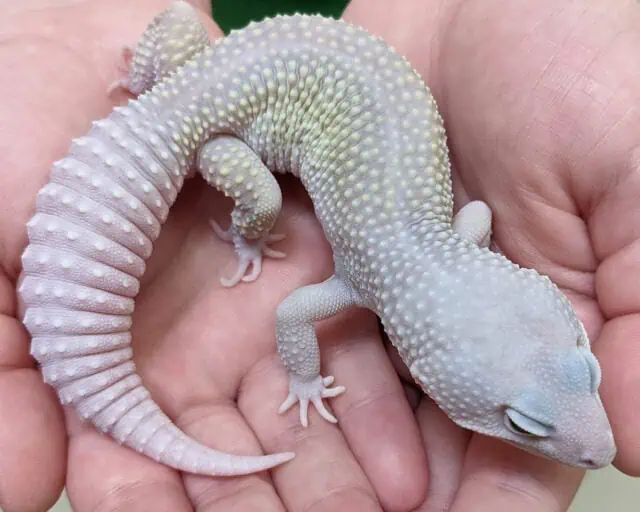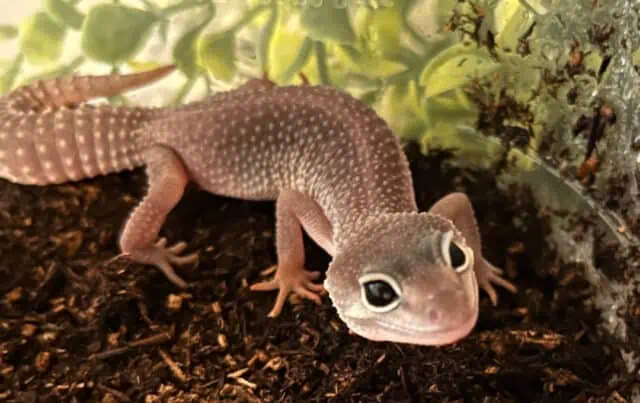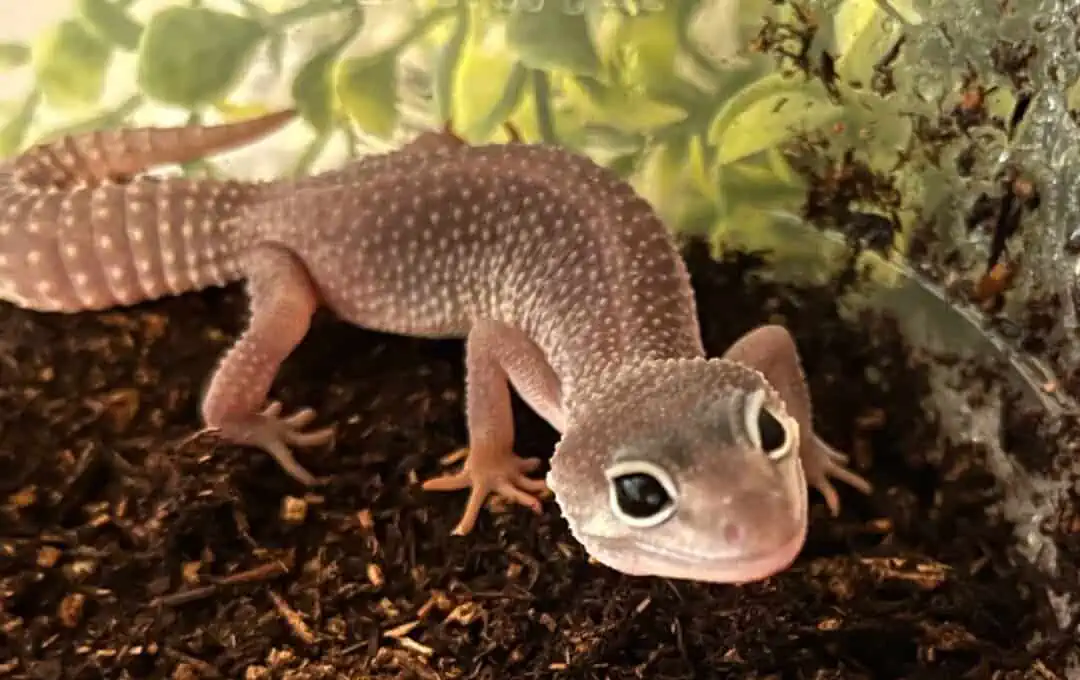The Blizzard Leopard Gecko is a captivating reptile that has garnered immense popularity among enthusiasts and pet owners alike. Known for its distinct appearance and engaging personality, this breed stands out in the world of reptiles.
When it comes to reptiles, each species carries its own set of unique traits and characteristics. The Blizzard Leopard Gecko is no exception. Renowned for its distinctive appearance and rich history, this Leopard Gecko morph offers a world of discovery for both the seasoned reptile lover and the budding enthusiast.
Originating from the arid regions of Afghanistan, Pakistan, and Northwestern India, this gecko has adapted to some of the world’s most challenging habitats. Its initial discovery in these native regions shed light on a creature that was both resilient and uniquely beautiful.
Tracing back the leopard gecko lineage, one finds a lineage that has evolved over millions of years, adapting to changing environments and survival challenges. The Blizzard variation, with its striking appearance, is a testament to nature’s way of producing wonders through genetic mutations and natural selection.
Blizzard Leopard Gecko Physical Characteristics

One of the standout attributes of the Blizzard Leopard Gecko is its mesmerizing physical appearance.
The most striking aspect is undoubtedly its color patterns. Unlike the typical leopard gecko, which sports a variety of spots and patterns, the Blizzard variation boasts a more uniform coloration. This can range from a pristine white to a soft lavender, creating a visual treat for the observer. The name “Blizzard” aptly describes its snow-like appearance, making it a favorite among breeders and enthusiasts. (a good alternative for some might be the Patternless Leopard Gecko).
Size-wise, the Blizzard Leopard Gecko is moderately sized, typically reaching a length of about 8-10 inches when fully grown. This makes it an ideal pet for those who have space considerations. Compared to a Giant Leopard Gecko morph, it’s tiny.
But it’s the minute details that truly captivate. Take its eyes, for instance. The eye colors can vary, but many display a deep, enchanting eclipse pattern, adding to the mystique of this creature. And then there’s the skin texture. Soft yet rugged, it’s a tactile reminder of the gecko’s adaptability to its native arid habitats.
Diving into gecko morphology, it’s evident that every aspect, from the tail to the toes, plays a role in its survival and daily life. The blizzard gecko appearance is not just about aesthetics; it’s a culmination of evolutionary brilliance.
Caring for a Blizzard Leopard Gecko

Stepping into the world of reptile ownership is a journey filled with discovery, responsibility, and immense rewards. And when your chosen companion is a Blizzard Leopard Gecko, the experience becomes even more enchanting. But like any pet, these geckos have specific needs and preferences that, when met, ensure their optimal well-being and happiness.
Ideal Habitat Setup
Creating the perfect environment for your Blizzard Leopard Gecko is paramount to its health and happiness. Just like we humans have preferences for our living spaces, these geckos, too, have specific needs that mirror their native habitats. Let’s delve into the intricacies of setting up a habitat that feels just like home for your gecko.
Cage Size
Begin with the basics. The size of the cage, or terrarium, plays a crucial role in ensuring your gecko has ample space to move, explore, and rest. For a single adult Blizzard Leopard Gecko, a 20-gallon terrarium is typically recommended. However, if you plan to house multiple geckos, you’ll want to consider a larger space to prevent territorial disputes.
Substrate Types
The floor of the terrarium, known as the substrate, should be chosen with care. While sand might seem like a natural choice given the gecko’s desert origins, it can pose ingestion risks. Instead, consider reptile carpet, paper towels, or tile. These provide a safe and easy-to-clean surface.
Heating
Heat is vital for these cold-blooded creatures. A reptile heating pad placed under one side of the terrarium creates a temperature gradient, allowing your gecko to choose its comfort zone. The warm side should hover around 88-92°F, while the cooler side can be between 75-80°F.
Lighting
While Blizzard Leopard Geckos are nocturnal and don’t require direct sunlight, UVB lights can be beneficial. These lights help in vitamin D3 synthesis, aiding in calcium absorption. If you opt for UVB lighting, ensure it’s not too intense and provide shaded areas for your gecko to retreat.
Diet and Nutrition for a Blizzard Leopard Gecko
One of the most rewarding aspects of owning a Blizzard Leopard Gecko is witnessing its feeding behaviors. These geckos, with their keen hunting instincts, bring a slice of the wild right into our homes. But it’s not just about the thrill of the hunt; ensuring a balanced and nutritious diet is paramount to their health and longevity. Let’s explore the dietary needs of these captivating creatures.
Food Preferences
Blizzard Leopard Geckos are primarily insectivores, which means their diet revolves around insects. Some of their favorites include crickets, mealworms, and dubia roaches. These insects serve as a source of protein and are usually relished by the geckos. It’s essential to choose insects that are appropriately sized – typically, the length of the insect should not exceed the space between the gecko’s eyes.
Feeding Frequency
Young geckos have a higher metabolism and thus require daily feedings, while adults can be fed every other day. The quantity can vary, but a general rule of thumb is to offer as many insects as the gecko can consume in a 15-minute period.
Supplements
While insects form the core of their diet, supplements are crucial to fill in any nutritional gaps. Calcium supplements are particularly vital, ensuring healthy bone development and preventing metabolic bone disease. Dusting the insects with a calcium powder before feeding is a common practice. Additionally, a multivitamin supplement can be introduced once a week to ensure a well-rounded diet.
Breeding
Breeding reptiles is a journey of patience, knowledge, and wonder. When it comes to the Blizzard Leopard Gecko, the experience is nothing short of magical. Witnessing the cycle of life, from courtship to hatching, offers a unique insight into the world of these fascinating creatures. But successful breeding doesn’t happen by chance. It requires a deep understanding of the gecko’s behaviors, needs, and environment.
Mating Behaviors
The dance of attraction in the animal kingdom is a spectacle, and the Blizzard Leopard Gecko is no exception. Their mating behaviors, a blend of subtle signals and overt displays, provide a captivating window into their reproductive world. Understanding these behaviors is crucial for anyone looking to breed these geckos successfully.
Signs of Readiness: Before the actual courtship begins, it’s essential to recognize when your geckos are ready to mate. Female geckos showcase a thickening of their body, indicating they are carrying eggs. In contrast, males often exhibit increased restlessness and a heightened interest in the females. Observing these signs can help breeders introduce potential mates at the right time.
Courtship Rituals: The dance of courtship is a delicate balance of pursuit and acceptance. Typically, the male initiates the process by approaching the female, often with a characteristic shaking of the tail. This is followed by circling, nudging, and gentle biting – all signs of his interest. The female, if receptive, will remain relatively still, allowing the male to continue his advances.
Male-Female Interactions: While the initial courtship displays can be gentle, it’s not uncommon for the interactions to become more forceful. The male might grip the female’s neck with his mouth during copulation. It’s crucial for breeders to monitor these interactions closely, ensuring that neither gecko gets hurt.
Breeding Season: Blizzard Leopard Geckos, like most of their counterparts, have a specific breeding season. This usually commences in the spring and can last through the summer. During this period, the geckos are more active, and their reproductive behaviors become more pronounced.
Egg Laying and Incubation
The miracle of life, encapsulated in tiny eggs, is a wonder to behold in the world of the Blizzard Leopard Gecko. From the moment a female lays her eggs to the hatching of baby geckos, every step is a testament to nature’s delicate balance. Successful egg laying and incubation require knowledge, care, and patience. Let’s delve into the intricacies of this phase in the gecko’s reproductive cycle.
Once successfully mated, female Blizzard Leopard Geckos seek out a suitable spot for laying their eggs. They prefer secluded, moist, and slightly cooler areas within their habitat. Providing a nesting box filled with a moist substrate, such as vermiculite or coco coir, can create an ideal environment for egg-laying.
Typically, a female will lay a clutch of two eggs, although this can vary. It’s essential to handle these eggs with utmost care, ensuring they remain in the same orientation as they were laid. Turning or flipping can harm the developing embryo.
After laying, the real challenge begins – incubation. The eggs need to be transferred to an incubator, where temperature and humidity can be closely monitored. The incubation period for Blizzard Leopard Geckos ranges from 35 to 89 days, depending on the temperature.
Temperature plays a pivotal role, not just in ensuring the eggs hatch but also in determining the sex of the hatchlings. A temperature range of 80-84°F generally produces females, while 87-90°F yields males. A middle range can result in a mix of both sexes. It’s crucial to maintain a consistent temperature to avoid any developmental issues.
Potential Health Issues
The world of the Blizzard Leopard Gecko is one of wonder and beauty, but like all living creatures, they are not immune to health challenges. As caretakers, it’s our responsibility to ensure their well-being, which means being vigilant about potential health issues.
From common ailments to signs of distress, understanding the health landscape of these geckos can be the difference between timely intervention and prolonged suffering.
Common Diseases
Blizzard Leopard Geckos, with their resilient nature and captivating presence, can sometimes mask their health issues until they become significant. Recognizing the early signs of common diseases and understanding their treatments is essential for any responsible owner. Let’s delve into some of the prevalent health challenges these geckos face and how to address them.
Metabolic Bone Disease (MBD): One of the most common ailments in captive geckos, MBD results from calcium and vitamin D3 deficiencies. Symptoms include soft or deformed bones, difficulty moving, and a swollen jaw. To treat MBD, it’s essential to provide a calcium-rich diet and ensure proper UVB lighting. Prevention is the best approach, so always dust insects with calcium powder and maintain a regular feeding schedule.
Respiratory Infections: Caused by bacterial agents, respiratory infections can result from cold habitats or poor cage hygiene. Symptoms include wheezing, labored breathing, and mucus around the nostrils. Immediate vet attention is required. Increasing the cage temperature slightly can help, but it’s vital to ensure the habitat is clean and appropriately heated to prevent such infections.
Parasitic Infections: Internal parasites can be a concern, especially if the gecko’s diet includes wild-caught insects. Signs include weight loss, lethargy, and irregular feces. A fecal test by a veterinarian can confirm the presence of parasites, followed by appropriate medication.
Shedding Issues: While shedding is a natural process, sometimes geckos face difficulties, leading to retained shed on toes, tails, or eyes. This can lead to constriction and potential loss of the affected body part. Regular baths and increasing humidity can help in easing the shedding process.
Conclusion
Embarking on the journey of understanding and caring for a Blizzard Leopard Gecko is both a privilege and a responsibility. These enchanting reptiles, with their captivating personalities and unique features, offer us a window into the wonders of the natural world. But beyond the marvels of their appearance and behaviors lies the profound realization that, like any living being, they rely on us for their well-being.
From grasping the intricacies of their origins to providing a nurturing habitat, every aspect of their care shapes their quality of life. Breeding, while a fascinating endeavor, comes with its own set of challenges and rewards, reminding us of the delicate balance of life. And, as with all creatures, being vigilant about potential health issues ensures that our geckos thrive and live their lives to the fullest.
FAQs
What sets the Blizzard Leopard Gecko apart from other gecko variants?
The Blizzard Leopard Gecko is unique due to its uniform coloration, which can range from a pristine white to a soft lavender. Unlike the typical leopard gecko that has spots and patterns, the Blizzard variant boasts a more consistent hue, giving it a snow-like appearance.
How often should I feed my Blizzard Leopard Gecko?
Young geckos require daily feedings due to their higher metabolism. However, as they mature, feeding every other day is sufficient. Always ensure the food is appropriately sized, and it’s a good practice to offer as many insects as the gecko can consume in a 15-minute period.
Do Blizzard Leopard Geckos require UVB lighting?
While they are nocturnal and don’t necessarily require direct sunlight, providing UVB lighting can be beneficial. UVB lights aid in vitamin D3 synthesis, which in turn helps in calcium absorption. If you choose to use UVB lighting, ensure the intensity isn’t too high and provide shaded areas for your gecko.
How can I tell if my gecko is experiencing health issues?
Regular observation is key. Look for changes in behavior, appetite, or physical appearance. Symptoms like lethargy, irregular feces, or difficulty moving can indicate potential health problems. If in doubt, always consult with a reptile veterinarian.
Can I house multiple Blizzard Leopard Geckos together?
While it’s possible to house multiple females together, caution should be exercised when introducing males, as they can be territorial. If you decide to keep multiple geckos in one habitat, ensure the space is large enough to prevent crowding and closely monitor their interactions to prevent any disputes.





